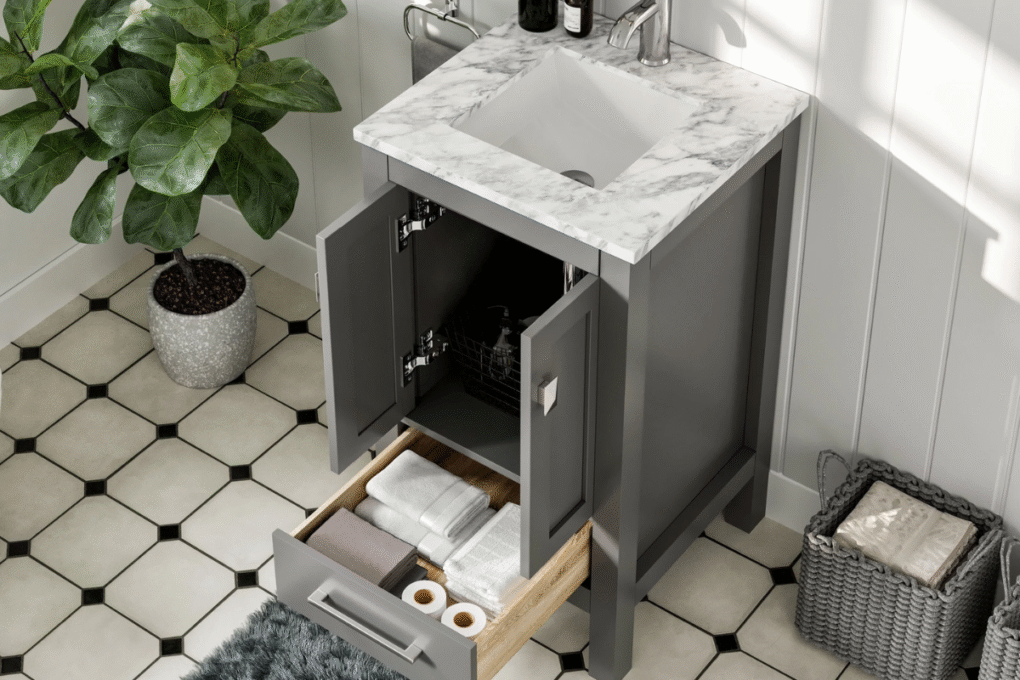Most people get mirror sizing completely wrong for compact vanities. They either go too small, making the vanity look unbalanced, or too large, which overwhelms the entire bathroom.
Here’s what works for a 20-inch bathroom vanity: you want a mirror that’s 16-18 inches wide and positioned 4-6 inches above the countertop. This creates proper visual proportion while maximizing functionality in small bathroom spaces.
The standard “70-80% rule” that works for larger vanities doesn’t always apply to compact 20-inch units. Small bathrooms have different visual dynamics, and the wrong mirror choice can make an already tight space feel cramped and awkward.
Intelligent homeowners understand that mirror sizing for compact vanities requires specific guidelines that account for both proportion and practical use. Here’s exactly what size mirror works best and why.
The Perfect Mirror Width for Your 20-Inch Vanity
The 80% Rule: Why 16-18 Inches is the Sweet Spot
For a 20-inch bathroom vanity, the ideal mirror width falls between 16-18 inches. This follows the principle that mirrors should be approximately 80% of the vanity width, but with compact vanities, you can push closer to 90% without overwhelming the space.
A 16-inch mirror provides comfortable visual balance while leaving 2 inches of vanity visible on each side. This creates a sense of proportion that doesn’t look cramped or undersized. An 18-inch mirror offers maximum reflection surface while still maintaining proper proportional relationships.
The key is avoiding mirrors that match the exact 20-inch width of your vanity. This creates a monotonous, box-like appearance that lacks visual interest and can make small bathrooms feel even more confined.
When to Go Wider: 20-22 Inch Mirrors That Still Work
In certain situations, you can use mirrors slightly wider than your 20-inch vanity. If your vanity sits in a larger wall area with plenty of surrounding space, a 20-22 inch mirror can work without looking oversized.
This approach works best when:
- The vanity is centered on a wall with at least 6 inches of space on each side
- You’re using a frameless mirror that doesn’t add visual weight
- The bathroom has high ceilings that can handle slightly larger proportions
However, proceed carefully with wider mirrors. In most small bathrooms where 20-inch vanities are used, going beyond 18 inches starts to create visual imbalance.
Avoiding Common Width Mistakes That Make Vanities Look Awkward
The biggest mistake is choosing mirrors that are too narrow; 14 inches or less makes a 20-inch vanity look disproportionately large and awkward. The vanity appears to dwarf the mirror, creating an unbalanced look that draws attention to the size mismatch.
Conversely, mirrors over 22 inches wide on a 20-inch vanity create the opposite problem. The mirror can overwhelm the vanity and make the entire bathroom feel cramped, especially in powder rooms or small guest bathrooms where space is at a premium.
Mirror Height and Placement Guidelines for Compact Vanities
Standard Height Rules vs Small Bathroom Reality
Standard bathroom design suggests mirrors should be approximately 30 inches tall, but this doesn’t always work with compact vanities in small spaces. For 20-inch vanities, mirrors between 24 and 30 inches tall provide better proportional balance.
The height should be proportional to your ceiling height and the available wall space. In bathrooms with 8-foot ceilings, a 24-inch-tall mirror often appears more proportionate than a 30-inch option, especially when paired with compact vanities.
Consider the overall scale of your bathroom. Small powder room benefit from slightly smaller mirrors that don’t overwhelm the space, while larger bathrooms can handle taller mirrors even with compact vanities.
Eye Level Considerations for Different User Heights
Position the mirror so the center sits at eye level for primary users. For average heights (5’3″ for women, 5’10” for men), this means the mirror center should be approximately 57-65 inches from the floor.
With compact vanities, you have less flexibility in height adjustment, so consider who uses the bathroom most frequently. If children regularly use the space, position the mirror slightly lower than you would for adult-only bathrooms.
Distance from Countertop: The 4-6 Inch Rule
The bottom edge of your mirror should sit 4-6 inches above the vanity countertop. This spacing prevents water splashing from reaching the mirror while providing optimal viewing angles for daily use.
“A bathroom mirror should typically be 70-80% the width of the vanity for a balanced look,” according to the American Society of Interior Designers. However, they note that spacing from the countertop matters just as much as width for proper functionality.
For 20-inch vanities with standard 32-inch heights, positioning the mirror’s bottom edge 5 inches above the countertop creates the most pleasing visual proportion while maintaining practical functionality.

Mirror Shapes and Styles That Work Best with 20-Inch Vanities
Round vs Rectangular: Which Shape Maximizes Visual Impact
Round mirrors often work exceptionally well with compact vanities because they don’t compete with the vanity’s linear edges. A 16-18 inch diameter round mirror provides excellent proportional balance while adding visual softness to small bathrooms.
Rectangular mirrors offer maximum reflection surface for their footprint, making them a practical choice for compact spaces. Choose rectangles with dimensions like 16″ x 24″ or 18″ x 26″ for optimal proportion with 20-inch vanities.
Avoid oval mirrors unless they’re sized explicitly for compact vanities. Standard oval mirrors often appear too large or create awkward proportional relationships with 20-inch vanities.
Framed vs Frameless Mirrors for Small Vanity Spaces
Frameless mirrors work particularly well with compact vanities because they don’t add visual weight or compete for attention. The clean lines complement small bathroom aesthetics while maximizing the apparent size of reflection surface.
If you prefer framed mirrors, choose thin frames (1-2 inches maximum) in colors that complement your vanity finish. Heavy or ornate frames can overwhelm compact vanities and make small bathrooms feel cluttered.
LED Mirrors and Lighting Considerations for Compact Bathrooms
LED mirrors provide excellent functionality for compact vanities by combining reflection and lighting in one element. Choose LED mirrors in the 16-18 inch width range to maintain proper proportional relationships.
Consider the lighting needs of your small bathroom. Compact spaces often lack natural light, making LED mirrors particularly valuable for providing adequate illumination for daily grooming tasks.
Common Mirror Sizing Mistakes to Avoid
- When Mirrors Are Too Large and Overwhelm the Space
Mirrors over 22 inches wide on 20-inch vanities create several problems. They make the vanity appear undersized, upset the visual balance of the room, and can make small bathrooms feel cramped rather than spacious.
Large mirrors also create practical issues in compact bathrooms. They may interfere with lighting fixtures, extend too close to walls or corners, or create awkward reflections that don’t enhance the space.
- Too Small Mirrors That Make Vanities Look Unbalanced
Mirrors under 14 inches wide make 20-inch vanities look disproportionately large and create an unfinished appearance. The vanity dominates the wall space while the mirror appears like an afterthought rather than an intentional design element.
Small mirrors also reduce functionality, providing an insufficient reflection surface for comfortable daily use. This defeats the practical purpose of having a mirror while creating poor visual aesthetics.
- Placement Errors That Reduce Functionality
Positioning mirrors too high forces users to stretch or strain to see their reflection properly. Too low, and taller users can’t see their full face without bending down awkwardly.
Centering issues create both aesthetic and functional problems. Mirrors that aren’t properly centered over the sink create awkward visual relationships and may not provide optimal reflection angles for actual use.
Measuring Your Space and Vanity Before You Buy
Measure your vanity width precisely; some “20-inch” vanities may measure 19 or 21 inches. Use the actual measurement for mirror sizing calculations rather than assuming standard dimensions.
Measure the available wall space above your vanity, taking into account any light fixtures, medicine cabinets, or other elements that may interfere with mirror placement. This prevents ordering mirrors that won’t fit your specific installation requirements.
Consider the depth of your vanity and any backsplash when measuring. Mirrors need adequate clearance from faucets and other fixtures to prevent water damage and maintain functionality.
The right mirror size makes a dramatic difference in how your compact bathroom looks and functions. Choose thoughtfully, and your 20-inch vanity will look perfectly proportioned rather than cramped or awkward.
Frequently Asked Questions
- What’s the exact best mirror size for a 20-inch vanity? 16-18 inches wide is optimal. A 16-inch mirror provides good proportion with some vanity showing, while an 18-inch mirror maximizes the reflection surface while maintaining visual balance.
- Can I use a 20-inch wide mirror on a 20-inch vanity? It’s possible but not recommended. Matching widths create a boxy appearance and lack visual interest. Slightly smaller mirrors (16-18 inches) create better proportional relationships.
- How high should I hang the mirror above a 20-inch vanity? Position the bottom edge 4-6 inches above the countertop, with the mirror center at eye level (approximately 57-65 inches from the floor for average adults).
